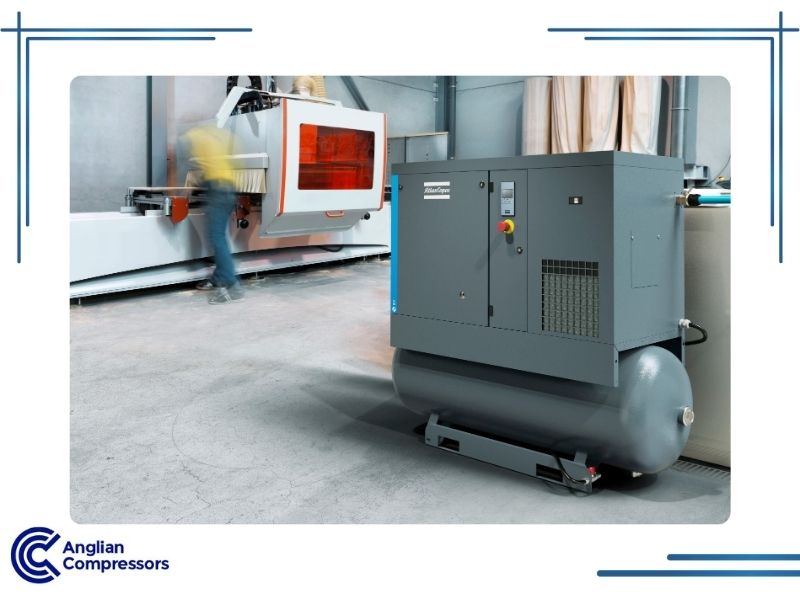The Impact of Cold Weather on Air Compressors
Winter brings challenges for air compressor users. You can run compressors in cold weather, but proper preparation is essential. At Anglian Compressors, a branch of Atlas Copco, we regularly help customers whose machines stop working when temperatures drop below 5°C, the typical minimum recommended by manufacturers.
Cold conditions affect several aspects of compressed air systems:
- Condensate may freeze in pipes and filters
- Compressor oil becomes thicker, making start-up difficult
- Air intake quality decreases
- Pipes and air lines can develop blockages
- Drying capacity reduces significantly
When temperatures plummet, moisture in the system can freeze, creating blockages that put extra strain on components. Valves, seals, and hoses may become brittle in the cold, leading to air leaks and unexpected downtime. This happened at several sites in East Anglia during particularly cold snaps last January.
To protect your equipment, keep the compressor room temperature above 5°C, use suitable low-viscosity lubricants for winter conditions, and check regularly for moisture in the system. One of our customers in Norfolk solved this problem by installing a simple space heater with a thermostat in their compressor housing.
Poorly insulated systems or those without proper winter preparation often develop problems with purge air flow and switching valves. In the worst cases, compressors shut down completely. At a manufacturing plant in Peterborough, we recently found ice forming overnight in the drain lines, causing pressure drops throughout the production line.
This article explains why these cold-weather issues occur, how they affect your entire compressed air system, and practical steps to keep your equipment running smoothly through the winter months.
1. Effects of cold temperatures on air compressors
The impact of cold weather on air compressors potentially worsens performance and causes defects and breakdowns. The design of air compressors allows them to function at temperatures above 5°C or 40°F. Freezing or sub-zero ambient temperatures are not their friends.
Below, we explain what can happen when attempting to operate compressed air systems in the lowest temperature ranges.
Starting difficulties:
Air compressors often have trouble starting when temperatures are in the single digits. Some compressor types include fail-safes to protect their internal parts.
For example, a temperature limit switch inside screw compressors prevents them from starting when temperatures are below 5°centigrade.
Battery performance degrades in frigid conditions. Operating in bone-chilling temperatures causes equipment to become overworked. The batteries drain faster, raising the electrical current and repeatedly tripping electrical breakers.
Increased oil viscosity:
Oil viscosity – its thickness and ability to lubricate equipment successfully – is seriously impaired.
Unfortunately, oil becomes thicker in cold temperatures, forcing motors to run harder to compensate. This adds extra strain to the compressor pump and related equipment, causing faster wear and a reduction in lifespan and increasing the potential for a breakdown.
Energy efficiency is affected, too. Higher amps are required to push the motor’s drive train. Consequently, energy costs rise.
Condensate freezing:
Air systems produce condensate through the compression process. It requires filtering to pass unimpeded through the compressed air piping and escape through the condensate drain.
Overly low internal temperatures cause frozen condensate. This prevents normal airflow and causes air pressurisation drops. Blockages also occur, affecting internal operations.
Moisture stuck in the air system and control lines freezing occurs at approximately 32° Fahrenheit. Drain valves freeze, heat exchangers crack, and air dryers suffer.
Component damage:
Seals and hoses are made from elastomer or rubber materials. These harden in the cold, resulting in reduced flexibility, and they may become brittle. This leads to leaking seals and cracked hoses, causing internal damage and potential downtime.
Both water fittings and hoses are vulnerable to temperature changes. They contract or expand in response to wide temperature variations, creating additional damage unless mitigated through temperature control.
Metallic components are not invulnerable either. Components alter their dimensions because of winter weather temperatures, creating unforeseen misalignment concerns within a larger compressor air generation system.
Talk with our experts at Anglian Compressors, a branch of Atlas Copco, to winter-proof your compressed air system.
2. Preventive measures for cold weather operation
Effective operation of air compressor systems in chilly weather is possible. However, initiative-taking measures are required to prevent performance degradation and equipment damage.
Maintain ambient temperature:
Compressor rooms and enclosures used as installation locations require heating to prevent ambient temperatures from falling to critical levels.
This applies to all air equipment, including air compressors, heat exchangers, and air dryers. Exposed machinery pipework and ducting networks, whether indoors or externally situated, require consideration.
Heat recovery, which harnesses waste heat from compressed air systems, is beneficial. However, complete dependence on this method to maintain warmer temperatures is ill-advised. Instead, portable heaters can be used as a separate heating source to rapidly increase internal room temperatures when needed.
Use appropriate lubricants:
Low-viscosity lubricants, designed to function well in colder temperatures, are essential. They reduce the degree to which oil thickens as temperatures decline. This avoids overworking motors, creating additional wear on parts, or using extra energy.
Frequently checking oil levels is vital. This helps to ensure that:
- There is sufficient oil volume.
- The oil has not become too thick, preventing successful lubrication.
- The lubricant has not degraded through overuse.
Regular drainage of condensate:
Condensate can freeze internally. Frozen condensate inside pipes can cause them to burst. Automatic drain valves may freeze or suffer ice-related surface blockages. Water becomes trapped, and air moisture levels increase in receiver tanks. Regular draining of condensate is required to prevent a build-up.
Chilly conditions compromise drying capacities. Refrigerated air dryers suffer from drain valves freezing in an open or closed position. This prevents water drainage via the condensate drain, leading to a moisture build-up and dryer shutdown.
Desiccant air dryers do not fare much better. Moist inlet air causes pipes to freeze, blocking control lines and preventing tower switching valves from operating properly. The discharge air purge muffler can also freeze, causing the machine to fail to dry air.
Insulate exposed components:
Add insulation to hoses, pipes, and valves. This reduces heat loss and keeps temperatures above freezing.
Look for exposed places, areas near frequently opened doorways, and partial outdoor installations. Insulate these locations to increase heat capture and retention – reroute foot traffic to maintain heat levels.
Implement heat tracing:
Apply heat tracing to components at risk of freezing. These heating elements wrap around pipework, drains, and other components. They provide a heat source to prevent internal ice build-ups.
Sensors should be added to monitor temperature levels in vulnerable areas. This will allow operators to move portable heaters to the affected areas before blockages or shutdowns occur.

3. Importance of regular maintenance
Winter maintenance is essential for air compressors. Cold weather affects various system components, with temperatures below 5°C causing problems like frozen water in pipes, thicker oil, and cracked hoses.
Check filters and air intakes weekly during winter. A customer in Ipswich found ice blocking their intake filter last December, which caused their machine to overheat despite the cold.
Desiccant dryers need special attention. Their switching valves can stick, and purge lines freeze when temperatures drop. At a small brewery in Norfolk, frozen purge lines led to moisture in their bottling line, causing a day of lost production.
Drain valves often freeze first. Check them daily in cold weather – even automatic ones can fail. Water trapped in the system leads to rust and internal damage. One of our engineers carries a flask of hot water on winter service calls specifically to thaw frozen drain valves.
Oil condition matters, too. Cold makes it thicken, which forces motors to work harder on startup. We recommend switching to a winter-grade oil when temperatures regularly fall below 10°C. It costs about £45 more per service but prevents much costlier motor repairs.
A proper winter service includes checking heater elements, insulating exposed pipes, and testing safety cutoffs. Most of our customers schedule this in October before the first frost, which is about 15% cheaper than emergency callouts.
Conclusion
Preparing appropriately for chilly temperatures extends the air compressor’s lifespan and improves operational efficiency. Failing to do so is far costlier in operational downtime and repairs than the winterisation process.
Talk with our experts at Anglian Compressors, a branch of Atlas Copco, to prevent damage to your air system. We can schedule a winterisation inspection and make appropriate recommendations.
Frequently Asked Questions
What problems can cold weather cause for my compressed air system?
Cold weather affects various parts of your compressor. Oil thickens below 5°C, making start-up harder. Water freezes in pipes and valves, blocking airflow. We have seen this happen with several units in Cambridgeshire when temperatures dropped to -3°C last winter. Frozen condensate can crack filters and damage dryer components. Even the plastic control panel buttons can become stiff and unresponsive.
Can I use my air compressor during the colder months?
Yes, with proper care. Keep your compressor room above 5°C – a standard 2kW workshop heater on a thermostat usually does the job. A joinery shop in Norwich solved their winter startup problems by moving their unit away from an exterior wall and adding a draught excluder to the door. Basic steps make a big difference.
How do I prevent freezing in my compressed air system?
Drain condensate daily during cold weather – it takes about 30 seconds but saves hours of downtime. Wrap exposed pipes with ordinary pipe lagging from any DIY shop. Check the oil colour weekly (it should be honey-coloured, not milky). Use winter-grade oil that flows at lower temperatures. We stock 4-litre containers for £27.50. Investing in a small cabinet heater (about £85) for your compressor housing can prevent most cold-weather issues.


